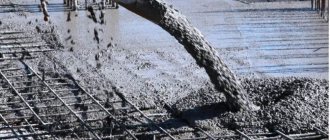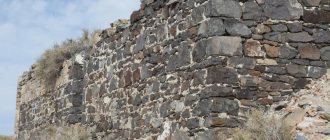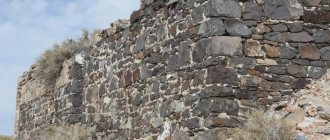It often happens that construction stretches over more than one season. The reason for this may be either the technology of construction work or a simple lack of time/resources/money.
My house was built first and took up the lion's share of the finances set aside and saved for construction. Our family did not have to rely on credit funds, since the interest on consumer loans is, to put it mildly, inhumane.
Naturally, adhering to the above philosophy, it was assumed that I would act according to the following plan:
- 1st year – pouring the foundation;
- 2nd year – construction of walls;
- 3rd year – roof installation;
And so it happened, in the first year there was barely enough finance to pour the foundation, so until better times he had to endure at least one winter. Then I thought, how can I save my work?
The answer came naturally - to cover the concrete for the winter in order to protect it as much as possible from the aggressive external environment.
The story was shared by my subscriber Arthur.
Why cover the foundation and what will happen if you don’t?
In our latitudes, unlike the tropics and the equator, the probability of winter coming is high. Against the backdrop of global warming, however, you wait for winter and don’t know whether it will be cold and harsh, or whether the children won’t even have to get skis and sleds.
However, if it suddenly happened as in my case - the foundation was poured, but nothing was built on it before the frost - you should definitely think about protecting it for the winter.
Now there will be a bit of boring theory and physics, which I didn’t like so much at school, but which needs to be mastered to understand processes hidden from view.
The main damaging factor for concrete will be water with its ability to increase in volume when it freezes. As ice increases, it can create microcracks in the foundation.
After melting, water penetrates deeper into the material and into cracks, and with the next freezing and expansion in volume it continues to destroy the concrete deeper and deeper.
That is why the foundation, regardless of the technology used to make it, must be covered for the winter.
Having read all sorts of things on the Internet about shelter, insulation and almost the construction of special structures, I began to wonder if all this that was written was not superfluous?
To ease my conscience, I decided to go around to my friends, ask them what they were doing, and whether they had any experience with preserving the foundation for the winter. To my surprise, I learned that the devil is not as scary as he is painted.
A set of concrete care measures
The finished mixture begins to harden after pouring into a mold or trench, and lasts approximately 28 days. During this time, it gains strength and requires careful treatment.
The maintenance and protection process includes a number of measures, we list them:
- protection against rapid drying;
- ensuring the required temperature;
- exclude physical impact;
- prevent the influence of the external environment - sun, frost, rain, snow;
- protect the water in it from freezing;
- provide hydration in sub-zero temperatures.
The optimal temperature for gaining strength is 20 degrees, air humidity 80%.
Covering strip foundations
Insulating concrete structures only makes sense if the foundation was poured immediately before frost. In this case, the reaction of water with cement did not complete and the concrete did not gain the required strength.
This is what they do when building in northern latitudes. I poured everything at the end of August, so there was plenty of time for the concrete of my foundation to gain strength.
According to my acquaintances, professional and not so much builders, the main point of protection is to prevent exposure to atmospheric precipitation. Any waterproof material will do for this.
With the help of ordinary film and a shovel, you can cover everything yourself for the winter. For a strip foundation, roofing felt, old slate, and pieces of tin will do.
This is how we protect a strip foundation from moisture
To begin with, I dismantled the wooden formwork, because the boards will absorb moisture, which is not good. Then I covered the foundation with film, sprinkling a little earth around the edges.
This will be quite enough. You can buy the film in a roll (about 3500₽) or by the meter - it’s more profitable. You can use a used one.
Since my sister has a greenhouse, every year she has the nth amount of used film left over, which she doesn’t know where to put. Armed with cookies, I visited her to resolve this issue.
After drinking tea, the remnants of the film successfully migrated to my foundation.
Some additionally paint the side edges of the concrete with bitumen-based mastics (about RUB 1,000 per 10-liter bucket). This processing will not be superfluous, although it is not entirely necessary.
I refrained from painting, which I don't regret. Looking ahead, I note that the foundation survived the winter quite successfully and without losses even without mastics under a used film.
If you use roofing felt (about 500₽ per roll) or old slate for shelter, you definitely need to press them on top with something heavy so that a gust of wind doesn’t blow all this happiness somewhere to a neighbor.
In this form, the foundation will wait for warming.
How can rainy weather affect the quality of a concrete base?
Since the foundation is a multi-layer structure, the work will be long and requires special attention, accuracy and experience from the concreting specialist. Rain is not a serious obstacle to the preparatory stage - there are no special instructions for this case in the regulations.
But during precipitation, you need to pay attention to several nuances:
- Soil composition. The soil should not be oversaturated with water. Unlike crushed stone and sand, which conduct liquid well, clay retains it, so it is better not to ignore this point.
- Method of pouring concrete. If the foundation has a complex non-standard shape, you will have to use construction vibration equipment for continuous pouring. But a large amount of precipitation can interfere in this case.
Cement is a hydraulic binder; it gains strength much faster under certain conditions: with air humidity levels of at least 80%. Therefore, some experienced builders believe that light rain or humid, cool weather will only benefit concrete: it will harden faster and this will increase the strength of the building.
You will have to use special equipment if the height of the foundation is significant. It will help displace excess moisture from the mixture and distribute the mass evenly throughout the structure. This equipment, of course, will not be cheap, but the result is worth it. If you don’t have it and you can’t purchase it, you need to compact the contents manually by tapping the wooden beams with a sledgehammer - this will create waves of vibration.
Covering a monolithic foundation
A monolithic foundation, unlike a strip foundation, has a much larger area. And this, as we know from theory, only increases the chances of cracking during constant freezing/thawing cycles of water.
By the way, I note that our asphalt roads in winter are exposed to no less impact than a monolith. So it turns out that in the spring we can see how “caries” has chewed up the road surface. This is because during construction there was no provision for drainage and drainage of water.
To protect a monolithic foundation for the winter, in addition to covering it with film, it is necessary to provide for moisture removal. If you simply cover such an area with strips of roofing felt or film, water will still flow in at the joints and do its dirty work.
Do we need it? Therefore, covering such an area will require more time and material.
Walking through our village under construction, I saw many foundation structures. There were also monoliths among them. Almost all of those that spent the winter were at the disposal of natural elements, that is, they were not covered by anything.
An example of covering a monolithic foundation
Only a few units were preserved. Out of curiosity, in the spring I walked the same route and noticed that the uncovered concrete was covered with crumbs.
First you need to think about how to drain the water. By analogy with the roof, you can use a single or gable drain.
It is more convenient and rational, in my opinion, to place a log in the middle, perpendicular to which to roll out the film or roofing felt. At the base, the edge of the shelter must be sprinkled with earth, and at the ridge, nailed to the log with slats.
A comment
- Registration: Nov 2012
- Posts: 148
Re: Concrete care
The cracks have already been sealed with cement laitance. New ones don't appear. So everything is fine with them.
Regarding the quality of concrete. Today we used a hammer to knock down cement laitance under the future walls. Some black stone came loose under the hammer drill. Like coal. Apparently it got in with the granite. Another fish surfaced after the vibration. Either some “kind” person threw it into the concrete (there are thoughts about who could have done this), or they took water/sand for the concrete from the river and the fish was sucked in. Although the concrete doesn’t smell like a river at all. Smells like concrete. In any case, both were hollowed out with a hammer drill.
Knowing that concrete can be made worse than it should be, I ordered the very best of those that were offered. Even if something is tricky, the required parameters for strength and water resistance will still be achieved. Yes, and he said that I would fill the cubes and demonstratively poured them from each concrete mixer. So far I have noticed that the concrete does not get wet deeper than 5-10 mm, although the water stood above it for a day.
I noticed something else interesting. The concrete mixers were washed after draining the concrete, and rivers of cement flowed along the road ditch. Then he grabbed it, I picked it up with a crowbar and threw it on the road. Nearby I threw a piece of concrete that had broken off from the “splash” that the concrete pump left after its washing and which we leveled into the expansion of the entrance area. So, cement stones were crushed into powder by machine wheels within a day. And a piece of concrete lies like flint and has only sunk slightly into the road made of rolled crushed stone. From which I concluded (which I probably already know everything about) that cement is only a binding component of concrete. And without sand and granite/gravel as a filler, it will not be able to bear any load and will crumble into powder. Those. There are apparently optimal strength ratios of cement, sand and granite/gravel. And pouring more cement in there in the hope of getting greater strength is wrong, because the result will be the opposite.
Covering screw piles
Again, a little theory so as not to bore you. Screw piles are usually made of metal. They are hollow; concrete is poured into this cavity.
If there is a light structure, such as a gazebo, on the stilts, they can remain hollow, and the upper end can be welded.
The main enemy of a hollow pile will be corrosion. Therefore, painting in several layers with anti-corrosion compounds (polyurethane paint at a price of approximately 1000 rubles per liter) will serve as protection not only for the winter, but for its entire life.
Screw piles are painted, ends are welded
If the structure of a more impressive gazebo, for example, a bathhouse or a frame house, rests on stilts, then in addition to painting the piles, which will be much thicker than their younger counterparts, concrete is poured inside, reinforcing it with several steel rods.
And concrete, as we learned earlier, is hygroscopic. If you do not close the top end for the winter, wet concrete can completely tear the pile.
Therefore, we need to cut plastic bottles of a suitable diameter and put the resulting caps on our steel pipes.
Once upon a time, while visiting a friend in a holiday village not far from the capital of our vast Motherland, I observed the installation of piles for a frame house.
At that time, my brain had not yet thought about building my own house, but the process of constructing a rather rare frame structure in our area attracted my attention. I noticed how liberally the piles were painted before they were screwed in.
To my curiosity, the owners noticed that they extensively treated the steel to combat unwanted corrosion. Moreover, after welding the ends on the twisted piles, everything that sticks out of the ground was covered again with mastic.
Causes of crack formation
If the technology for pouring concrete is violated or due to poor quality care for it until it reaches sufficient strength, various types of cracks can form:
- In the first 1.5-2 hours, while the concrete retains its plasticity, shrinkage may occur. The cause of shrinkage is a rapid decrease in the volume of the surface layer as a result of dehydration occurring under the influence of wind, sun or low temperatures. Longitudinal cracks originate above the upper reinforcement; such a defect can be avoided by carefully preparing the mixture and repeated vibration, which is carried out before the solution sets.
- Premature plastic shrinkage occurs in the first 1-2 hours after pouring concrete. The reason for its manifestation is the drying of concrete and compression of the outer surface layer. Surface cracks do not have a specific direction. Premature plastic shrinkage can be prevented by reducing the drying rate of the concrete; you can resort to repeated vibration before the mixture sets.
- The release of heat of hydration is observed in the first days after concreting due to the heating of the concrete core while the shell is cooling due to contact with the atmosphere and soil. Due to temperature differences, compressive stresses are formed, which lead to the appearance of surface or through cracks. It is possible to prevent the appearance of cracks due to the release of heat of hydration by installing expansion joints.
- Drying shrinkage may occur several weeks after concrete is poured in the form of surface and through-hole cracks. Such shrinkage can be avoided by proper selection of the mixture, strong reinforcement and construction of expansion joints.
- Temperature deformations can occur at any time during the operation of concrete due to sudden temperature changes. Deformation manifests itself in the form of bending cracks or surface cracks. Temperature deformations can be avoided by reinforcement, construction of expansion joints, and prestressing of reinforcement.
- Mechanical deformations can occur at any time and manifest themselves in the form of through cracks and bending cracks. This disadvantage can be avoided by reinforcing, prestressing reinforcement, and installing expansion joints.
- Its own stress state can cause the appearance of various cracks at any time during operation. Such negative impacts can be avoided with proper reinforcement.
- Bending cracks, as well as external microcracks as a result of external loading, can occur at any time during operation. Correct reinforcement can prevent concrete from deforming due to external load.
- Cracks along the reinforcement or in the area of water-filled voids due to frost can occur when exposed to extremely low temperatures. The effect of frost can be neutralized by high-quality vibration compaction of the mixture.
- Cracks in the corners of building elements and along the reinforcement may appear several years after concreting due to corrosion of the reinforcement. Such defects can be avoided by observing technological standards for constructing a protective layer, as well as by eliminating contact of the reinforcement with the ground.
Covering columnar foundations
A columnar foundation is something between strip and pile foundations. It is either made simply from concrete, or a brick cabinet is laid on a concrete base. Sometimes a grillage is poured between the pedestals.
Pillars with reinforcement extended under the grillage, covered with film
I even witnessed the construction of a house on such a foundation by a student classmate. Let's just say, a rather atypical solution for a foundation in our area, but quite justified on clay soils.
He, like me, did not have the resources to build everything in one season. For the winter, he simply covered everything with old slate, thereby keeping the foundation safe and sound for the next season.
Since we are dealing with the same concrete, the cabinets, like the grillage, can be wrapped in film for the winter.
What conclusions did I draw?
Summarizing all of the above, I want to say that the best shelter for any type of foundation for the winter will be erected walls. And if you still manage to install the roof before winter, it will be simply excellent.
I tried my best to complete these steps so that I wouldn’t have to deal with temporary shelters for the second winter in a row - and I succeeded.
I think that, having tinkered with films, roofing felt, slates for one year, you yourself will not want to repeat the feat next year and you, like me, will try to have time to build the walls. Do you agree?











